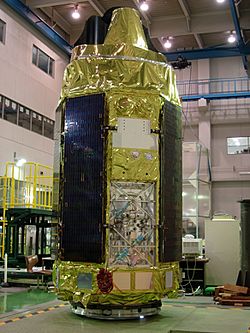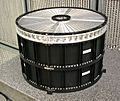Suzaku (satellite) facts for kids

A picture of a fully integrated Astro-E2 before vibration tests at ISAS/JAXA.
|
|
| Mission type | Astronomy |
|---|---|
| Operator | JAXA / NASA |
| Mission duration | Planned: 2 years Actual: 10 years, 1 month, 23 days |
| Spacecraft properties | |
| Manufacturer | Toshiba |
| Launch mass | 1,706 kilograms (3,761 lb) |
| Start of mission | |
| Launch date | 2005-07-10, 03:30:00 UTC |
| Rocket | M-V-6 |
| Launch site | Uchinoura Space Center Uchinoura, Kagoshima, Japan |
| End of mission | |
| Decay date | no earlier than 2020 |
| Orbital parameters | |
| Reference system | Geocentric |
| Regime | Low Earth |
| Perigee | 550 kilometres (340 mi) |
| Apogee | 550 kilometres (340 mi) |
| Inclination | 31 degrees |
| Period | 96 minute |
| Main telescope | |
| Wavelengths | X-ray |

The M-V rocket carrying ASTRO-E veering off course after launch on 10 February 2000.
|
|
| Operator | Institute of Space and Astronautical Science (ISAS) |
|---|---|
| Start of mission | |
| Launch date | 01:30:00, February 10, 2000 (UTC) |
| Rocket | M-V-4 |
| Launch site | Kagoshima Space Center |
Suzaku (すざく) is the name of the a Japanese artificial satellite which was put into orbit in 2005.
The launch was a project of the Institute of Space and Astronautical Science of the University of Tokyo.
The satellite was launched on July 10, 2005.
Images for kids
See also
 In Spanish: ASTRO-E para niños
In Spanish: ASTRO-E para niños

All content from Kiddle encyclopedia articles (including the article images and facts) can be freely used under Attribution-ShareAlike license, unless stated otherwise. Cite this article:
Suzaku (satellite) Facts for Kids. Kiddle Encyclopedia.




